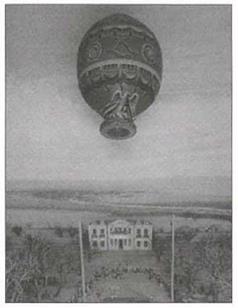Aeronauts and the Balloon Revolution
For millennia, men and women crowding around crackling fires and steaming pots noticed a universal constant: Smoke rises. That principle is so simple that it’s not clear why humankind waited until the eighteenth century to create a hot-air balloon and try to take to the skies. In fact, the simple fabric that the first balloons were made of has been available since the time of the ancient Sumerians and Egyptians.
|
Turbulence It took people until the 1700s to ; invent the hot-air balloon, but і that doesn’t mean people weren’t thinking about it long before then. A Jesuit priest named Francesco de Lana wrote in 1670 that four copper spheres with most of the air sucked out of them would become buoyant, and could be tethered to a gondola equipped with a sail. |
A Lot of Hot Air
In 1783, two French brothers named Joseph and Etienne Montgolfier made what is considered to be the first vehicle to achieve sustained flight—a hot-air balloon.
The brothers, who were inventors, were experimenting one day at their paper factory when they noticed that a paper bag rose toward the ceiling when it was filled with hot air. They tried filling another bag with steam, but the water vapor soaked the paper and weighed it down. They held bags over a fire and found that the bags rose quickly and remained aloft as long as the air inside stayed hot.
The Very First Aviators
Knowing they were on to something big, the brothers announced they were ready to publicly display their invention. On June 4, 1783, the Montgofiers staged a Paris demonstration for Louis XVI and Queen Marie Antoinette, and their full-size balloon created a Gallic sensation. Worried that the air a few hundred feet off the ground
might be too thin to breathe, the brothers didn’t actually participate in the ascension—they left those honors to a sheep, a chicken, and a duck. While an enormous crowd watched, the animals slowly ascended 1,700 feet into the sky. The sheep and duck were unharmed in the return to earth, but the chicken broke its neck on landing and wound up that evening as part of a family’s dinner.
|
Hot air kept early balloons aloft, and the onboard fire that provided the heat kept pilots on the alert for embers that could ignite the delicate paper the first balloons were made of. |
The first human balloon flyers, or aeronauts, in history were not the Montgofier brothers, but two French courtiers named Jean-Francois Pilatre de Rozier and Francois Laurent, the Marquis d’Arlandes. They stoked a fire in the balloon the Montgolfier brothers had built and lifted off from the verge of the Boulogne forest near Paris and
drifted to a safe landing five miles downwind. The two men set a number of “firsts” in aviation history, including sustaining a prolonged flight in a craft they powered themselves—in this case by keeping a fire burning under the balloon’s envelope.
|
By the Book If the word aeronaut (oundi vaguely familiar, it should. Aeronaut, the name balloon flyers call themselves, derives from Greek words meaning "voyager of the air." Likewise, "astronaut" means "voyager to the stars," while the Russian word "cosmonaut" means "voyager to the universe." |














